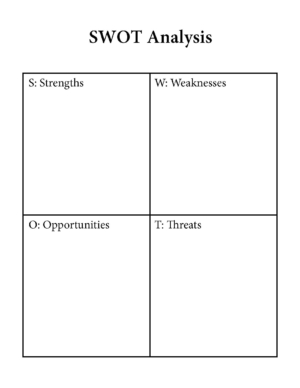Establishing routines wherein students continually face formative tasks can boost achievement tremendously. The frequent use of formative assessments such as the SWOT analysis technique is recommended when you, the CTE teacher, want to push your students further. SWOT stands for strengths, weaknesses, opportunities and threats. This strategy involves microteaching (.88 effect size), and strategies are designed to integrate new learning with prior knowledge (.93 effect size) (Hattie, 2009).
SWOT analysis strategies are best used to review for performance testing and can also be helpful when attempting to solve a problem. Students examine strengths, weaknesses, opportunities and threats to gain a well-rounded understanding of any idea. Examination complete, they evaluate the given variables before taking the next step in their process.
The Strategy in Action
How it Works

- Divide students into groups. Or choose to keep the whole class together.
- Distribute a blank SWOT diagram each group. Or have students create a large version on the board or on chart paper. (Note: If you use a large diagram on the board, have students write their ideas on sticky notes. These allow you to move ideas between boxes. And as a bonus, they get students out of their seats.)
- Present students with a topic, video clip or written scenario. For example, you might show a video of an interaction with a customer.
- Say, “As a group, analyze the video through four different lenses: strengths, weaknesses, opportunities and threats. Jot down ideas in each box as you go.” In the customer interaction example given, students would analyze the actions and words of the employee and gauge customer satisfaction. (Note: Don’t feel constrained to the exact terminology on the diagram. For example, if your situation does not include any threats, use the word “tweaks” instead. Leverage the tools available to help students brainstorm possible challenges.)
- Lead a group discussion of the positive and negative aspects of the topic. For a customer interaction, challenge students to suggest changes the worker could make.
For an added twist
Have student groups practice performance testing and record themselves on video. Then have groups trade videos and analyze each other’s actions using a SWOT analysis.
Final Thoughts
The SWOT Analysis is one formative tool that provides a lot of flexibility for use. You can use this as a pre-assessment, while reading or delivering content, or as a post-instruction tool. It works to emphasize collaboration, connections and synthesizing information. It also serves as an efficient tool for connecting new information to prior learning. The gist: The SWOT analysis will encourage your students to think critically; implement this strategy in your classroom today.
Sandra Adams is a teacher and instructional coach with the Career Academy, Fort Wayne Community Schools. She co-wrote the ACTE-supported book But I’m NOT a Reading Teacher!: Literacy Strategies for Career and Technical Educators with Gwendolyn Leininger. Email her.






